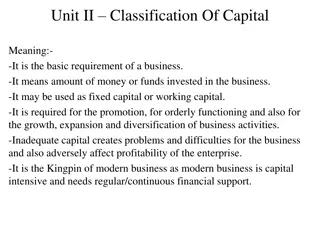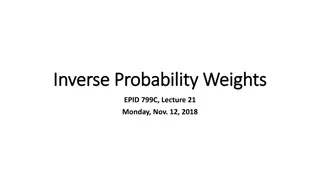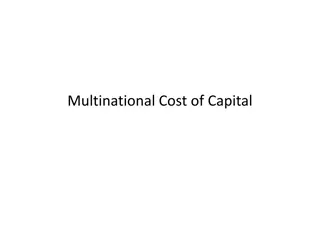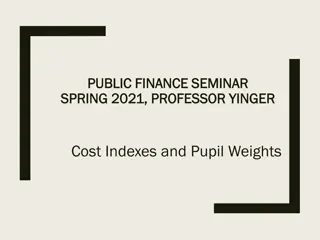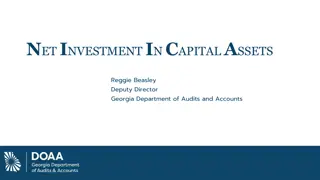Historical Weights and Cost of Capital Analysis
The content discusses historical weights using market value weights for different securities like mortgage bonds, preferred stock, and common stock. It also delves into determining the overall cost of capital based on market value weights, including debt, preferred stock, common stock, and retained earnings. The concept of measuring the overall cost of capital using target weights and the relationship between the level of financing and the marginal cost of capital are explored in detail.
Download Presentation

Please find below an Image/Link to download the presentation.
The content on the website is provided AS IS for your information and personal use only. It may not be sold, licensed, or shared on other websites without obtaining consent from the author.If you encounter any issues during the download, it is possible that the publisher has removed the file from their server.
You are allowed to download the files provided on this website for personal or commercial use, subject to the condition that they are used lawfully. All files are the property of their respective owners.
The content on the website is provided AS IS for your information and personal use only. It may not be sold, licensed, or shared on other websites without obtaining consent from the author.
E N D
Presentation Transcript
EXAMPLE, Historical Weights, using Market Value Weights In addition to the data from Ex. 10.7, assume that the security market prices are as follows: Mortgage bonds = $1,100 per bond Preferred stock = $90 per share Common stock = $80 per share 10 1
EXAMPLE , Historical Weights, using Market Value Weights, continued The firm s number of securities in each category is: Mortgage bonds = 44.5% 20 $ , 000 000 , = 20 000 , , 1 $ 000 $5, 000 000 , Preferred stock = 11% = 50 000 , $100 Common stock = 44.5% $20, 000 000 , = 500 000 , $40 10 2
EXAMPLE, Historical Weights, using Market Value Weights, continued Source Number of Securities Price Market Value Debt 33% Preferred 7% Common 60% 20,000 50,000 500,000 $1,100 $90 $80 $22,000,000 4,500,000 40,000,000 $66,500,000 The $40 million common stock value must be split in the ratio of 4 to 1 (the $20 million common stock versus the $5 million retained earnings in the original capital structure), since the market value of the retained earnings has been impounded into the common stock. 10 3
EXAMPLE, Historical Weights, using Market Value Weights, continued The firm s cost of capital is as follows: Source Market Value Weights Cost Weighted Avg. Debt Preferred stock Common stock Retained earnings $22,000,000 4,500,000 32,000,000 48.12 8,000,000 12.03 $66,500,000 33.08% 6.77 5.14% 13.40% 17.11% 16.00% 1.70% 0.91 8.23 1.92 12.76% 100.00% Overall cost of capital = ka = 12.76% 10 4
MEASURING THE OVERALL COST OF CAPITAL, Target Weights If the firm has determined the capital structure it believes most consistent with its goal, the use of that capital structure and associated weights is appropriate. 10 5
LEVEL OF FINANCING AND THE MARGINAL COST OF CAPITAL (MCC) Because external equity capital has a higher cost then retained earnings due to flotation costs, the weighted cost of capital increases for each dollar of new financing. Therefore, lower-cost capital sources are used first. The firm s cost of capital is a function of the size of its total investment. A schedule or graph relating the firm s cost of capital to the level of new financing is called the weighted marginal cost of capital (MCC). 10 6
LEVEL OF FINANCING AND THE MARGINAL COST OF CAPITAL (MCC), continued This schedule is used to determine the discount rate to be used in the firm s capital budgeting process. The steps to be followed in calculating the firm s marginal cost of capital are: (1) Determine the cost and the percentage of financing to be used for each source of capital (debt, preferred stock, and common stock equity). 10 7
LEVEL OF FINANCING AND THE MARGINAL COST OF CAPITAL (MCC), continued (2) Compute the break points on the MCC curve where the weighted cost will increase. The formula for computing the break points is: Break point = maximum amount of the lower -cost source of capital percentage financing provided by the source 10 8
LEVEL OF FINANCING AND THE MARGINAL COST OF CAPITAL (MCC), continued (3) Calculate the weighted cost of capital over the range of total financing between break points. (4) Construct an MCC schedule or graph that shows the weighted cost of capital for each level of total new financing. 10 9
LEVEL OF FINANCING AND THE MARGINAL COST OF CAPITAL (MCC), continued This schedule will be used in conjunction with the firm s available investment opportunities schedule(IOS) in order to select the investments. As long as a project s MIRR is greater than the marginal cost of new financing, the project should be accepted. The point at which the IRR intersects the MCC gives the optimal capital budget. 10 10
EXAMPLE, LEVEL OF FINANCING AND THE MARGINAL COST OF CAPITAL (MCC) This example illustrates the procedure for determining a firm s weighted cost of capital for each level of new financing and how a firm s investment opportunity schedule (IOS) is related to its discount rate. 10 11
EXAMPLE, LEVEL OF FINANCING AND THE MARGINAL COST OF CAPITAL (MCC), continued A firm is contemplating three investment projects, A, B, and C, whose initial cash outlays and expected MIRR are shown below. IOS for these projects is: Project Cash Outlay MIRR A B C $2,000,000 $2,000,000 $1,000,000 13% 15% 10% 10 12
EXAMPLE, LEVEL OF FINANCING AND THE MARGINAL COST OF CAPITAL (MCC), continued If these projects are accepted, the financing will consist of 50% debt and 50% common stock. The firm should have $1.8 million in earnings available for reinvestment (internal retained earnings). The firm will consider only the effects of increases in the cost of common stock on its marginal cost of capital. 10 13
EXAMPLE, LEVEL OF FINANCING AND THE MARGINAL COST OF CAPITAL (MCC), continued (1) The costs of capital for each source of financing have been computed and are: Source Cost Debt Common stock ($1.8 million) New common stock 5% 15% 19% 10 14
EXAMPLE, LEVEL OF FINANCING AND THE MARGINAL COST OF CAPITAL (MCC), continued If the firm uses only internally generated common stock, the weighted cost of capital is: ko= percentage of the total capital structure supplied by each source of capital X cost of capital for each source 10 15
EXAMPLE, LEVEL OF FINANCING AND THE MARGINAL COST OF CAPITAL (MCC), continued In this case the capital structure is composed of 50% debt and 50% internally generated common stock. Thus, ka = (0.5)5% + (0.5)15% = 10% If the firm uses only new common stock, the weighted cost of capital is: ka = (0.5)5% + (0.5)19% = 12% 10 16
EXAMPLE, LEVEL OF FINANCING AND THE MARGINAL COST OF CAPITAL (MCC), continued This can be seen in chart form: Range of Total New Financing Type of Capital Weighted Cost Proportions Cost $0 - $3.6 Debt 0.5 0.5 5% 15% 2.5% 7.5 10.0% Internal Common $3.6 and up Debt 0.5 0.5 5% 19% 2.5% 9.5 12.0% New Common http://upload.wikimedia.org/wikipedia/en/8/87/Old-style_Stop_Sign(MUTCD).png 10 17
EXAMPLE, LEVEL OF FINANCING AND THE MARGINAL COST OF CAPITAL (MCC), continued (2) Next compute the break point, which is the level of financing at which the weighted cost of capital increases. maximum amount of the lower - cost source of capital Break point = percentage financing provided by the source $1, 800 000 05 , = = $3, 600 000 , . 10 18
EXAMPLE, LEVEL OF FINANCING AND THE MARGINAL COST OF CAPITAL (MCC), continued (3) The break point tells us that the firm will be able to finance $3.6 million in new investment with internal common stock and debt without having to change the current mix of 50% debt and 50% common stock. Therefore, if the total financing is $3.6 million or less, the firm s cost of capital is 10% 10 19
EXAMPLE, LEVEL OF FINANCING AND THE MARGINAL COST OF CAPITAL (MCC), continued This brings everything together (4) Construct the MCC schedule on the IOS graph to determine the discount rate to be used in order to decide in which project to invest and to show the firm s optimal capital budget 10 20
MCC schedule and IOS graph WACC and the Marginal cost of capital (MCC) 20 MIRR 16 MIRR B 12 A MIRR C 8 4 0 3.6 4 6 2 Total new financing 10 21
EXAMPLE, LEVEL OF FINANCING AND THE MARGINAL COST OF CAPITAL (MCC), continued The firm should continue to invest up to the point where the IRR equals the MCC. From the graph, note that the firm should invest in projects B and A, since each IRR exceeds the marginal cost of capital. 10 22
EXAMPLE, LEVEL OF FINANCING AND THE MARGINAL COST OF CAPITAL (MCC), continued The firm should reject project C since its cost of capital is greater then the IRR. The optimal capital budget is $4 million, since this is the sum of the cash outlay required for projects A and B. 10 23
Dividend Policy Chapter 16 24
Learning Objectives Factors that influence dividend policy How to pay dividends Major dividend theories Alternatives to cash dividends 25
Factors in Dividend Policy Need for funds Management expectations for the firm s future prospects Stockholders preferences Restrictions on dividend payments Availability of cash 26
Dividend Reinvestment Plans A dividend reinvestment plan (DRIP) is a plan in which stockholders are allowed to reinvest their dividends in additional shares of stock instead of receiving them in cash. Popular with investors because they can avoid commission costs. Dividends paid and reinvested are still taxable income to the investor. 27
Leading Dividend Theories Residual Theory of Dividends Hypothesizes that dividends should be determined only after the firm has first examined their need for retained earnings to finance the equity portion of funds needed for their capital budget. Thus, dividends arise from the residual or left-over earnings. 28
Leading Dividend Theories Residual Theory of Dividends Example: Net Income = $150 million Total Amount of Funds Needed to Finance Positive NPV Projects = $100 million Optimal Capital Structure: 60%D, 40%E Equity Funds Needed = $100 million x .4 = $40,000,000 Dividend to be Paid = $110 million ($150 million NI - $40,000,000 Equity Funds Needed) 29
Leading Dividend Theories Clientele Dividend Theory Hypothesizes that different firms have different types of investors. Some investors, such as elderly people on fixed incomes, tend to prefer to receive dividend income. Others, such as young investors often prefer growth, and tend to like their income in the form of capital gains rather than as dividend income. 30
Leading Dividend Theories Signaling Dividend Theory Hypothesizes that since management is better informed about the firm s prospects, dividend announcements are seen as signals of future performance. Since investors usually respond negatively to dividend decreases, managers tend not to increase dividends unless the increase is expected to be sustainable. 31
Leading Dividend Theories Bird in the Hand Theory Hypothesizes that stockholders prefer to receive dividends instead of having earnings reinvested. The dividend payment is more certain than the unknown future capital gain. 32
Leading Dividend Theories Modigliani and Miller Dividend Theory M&M originally argued in 1961 that, without taxes or transactions costs, the way that the firm s earnings are distributed (capital gains versus dividends) is irrelevant to firm value. 33
Alternatives to Cash Dividends Stock Dividends Existing shareholders receive additional shares of stock instead of cash dividends. Payment is expressed as a percentage of current stock holdings. e.g. if there is a 10% stock dividend, you would receive one additional share for every 10 that you currently own. 34
Alternatives to Cash Dividends Stock Splits If total shares will increase by more than 25%, the company will usually declare a stock split. Purpose is usually to bring the stock price into a more popular trading range. Expressed as a ratio to original shares. e.g. a 2-1 split means that each investor will end up with twice as many shares. 35
Homework Problems and Questions 1. Explain the difference between a stock dividend and a stock split. 2. Net income is $2,500,000; dividends declared are $500,000. What is the dividend payout ratio? 3. Why is it important for a firm to understand the makeup of its stockholders before it determines a dividend policy? 4. Would it be a common practice for a high-growth firm to have a 100% dividend payout ratio? Explain. 5. What is the rationale of managers who view a stock split as a way to increase the total value of their firm s stock? 36





















